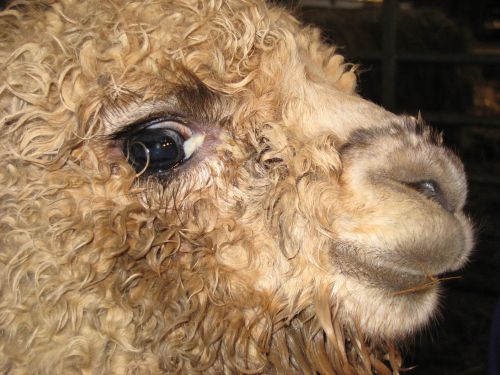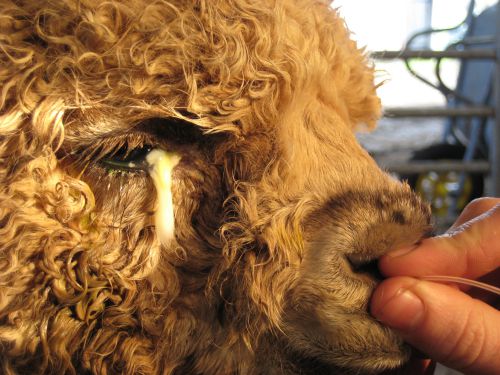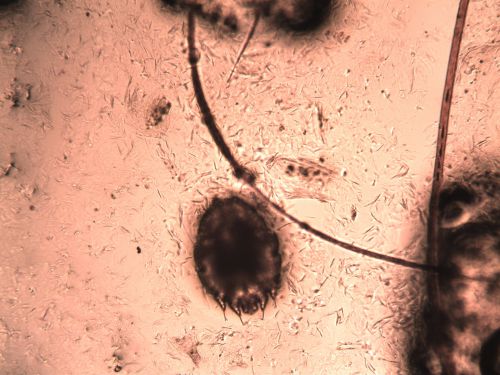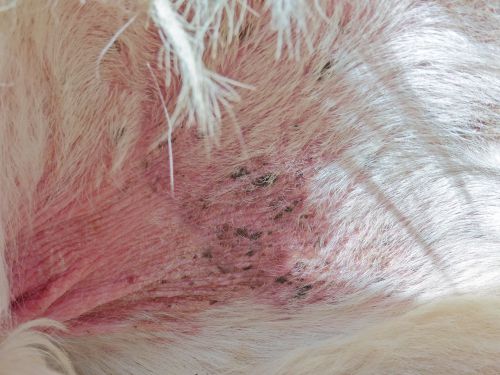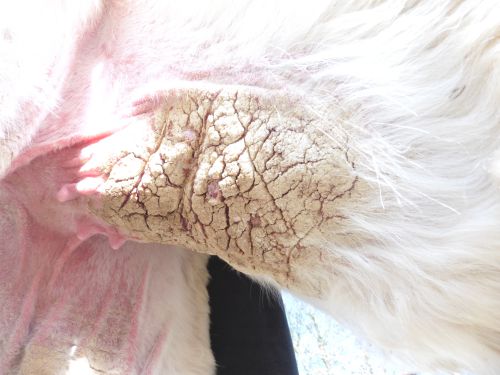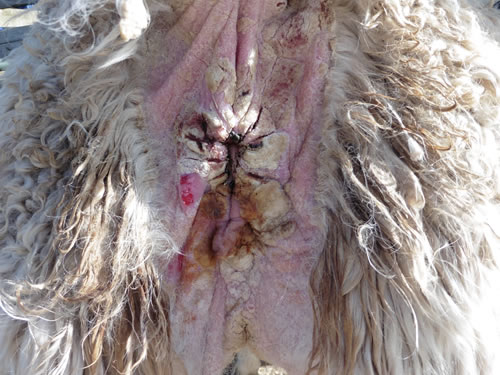We are able to help with virtually any camelid health concern. Some of the routine investigations or procedures available are listed below.
Blocked tear ducts | Dental work | Castration | Dermatology | Weight loss investigation | Neonatal care | TB Support | Other medical concerns
Blocked tear ducts
Young camelids occasionally have persistent problems with tear-staining of the face or recurrent bouts of conjunctivitis. Most of the time, a simple course of eye ointment prescribed by your vet will resolve conjunctivitis, but sometimes the tear ducts may become plugged up with gunge (cellular debris and pus) and repeated episodes of conjunctivitis occur. These cases may not resolve without flushing of the tear ducts.
On occasion, there may be a congenital defect present in which there is no opening of the tear duct at either or both ends of the duct (this is called “nasolacrimal duct atresia”). “Congenital” means that the problem has been present from birth – whether or not this particular defect is hereditary or not is unknown. Tear duct flushing can be challenging in alpacas particularly if the duct openings aren’t evident: therefore this may need to be a referral procedure. Tear duct flushing is performed under sedation but is quite quick and patients are able to go home the same day.
Dental work
Incisor or fighting tooth trimming
Trimming of incisor teeth is only necessary due to poor dental conformation. It is not ever required as a routine procedure in camelids since incisors will wear down naturally during grazing in animals with normal dental conformation. Overgrowth of incisors can occur if the bottom jaw extends out beyond the upper jaw so that the incisors do not touch the dental pad and wear during grazing. It can also occur if the incisor teeth are set at a flatter angle such that they again do not meet the dental pad. Assessment of whether or not the incisor teeth require trimming is best made by a vet who can trim the incisors under sedation to minimise the stress occurring to the animal during trimming. It is important to ensure that not too much tooth is removed as that can result in exposure of the pulp canal that will be painful and may lead to infection in the tooth roots. Use of some imported dental trimming devices by untrained personnel may result in inappropriate trimming and sharp edges that cause wounds to the gums and lips.
Male camelids develop fighting teeth and these erupt at an average age of around 2.5 to 3.5 years old. These are essentially weapons for male camelids that are used to cause damage to an opponent’s limbs or scrotum: males, particularly those within sight, smell and sound of breeding-age females will fight and cause injury to paddock-mates with these sharp teeth and therefore these teeth are usually trimmed to blunt them. Depending on the stage of dental development when this is first done, the procedure may only be required on one occasion. Again it is important that the correct tools are used for this: clippers should never be used as they can fracture the teeth resulting in pain and infections.
Not all vets carry the correct equipment for dental trimming in alpacas, and they may suggest calling us to carry out either of these procedures. Alternatively you may call us directly.
Tooth root abscesses
Tooth root abscesses may present in any age of animal, but are most common in animals aged 2-5 years. The clinical presentation of tooth root abscesses is typically with that of a hard, bony swelling over the jaw. The abscess may have ruptured. There may be quite extensive soft tissue inflammation that may also make the swelling painful to palpate. Alpacas and llamas with tooth root abscesses will tend to eat normally but may exhibit weight loss or stop eating in some cases. Tooth root abscesses occurring in the upper jaw are less frequent, but harder to detect. Occasionally they may present with purulent nasal discharge, or no discharge, and occasionally they may rupture externally; any facial swelling may be subtle and hard to detect clinically in affected individuals.
Some tooth root abscesses may resolve with appropriate antibiotic therapy. However, some may fail to resolve or re-occur in which case diagnostic imaging can help evaluate the extent of the problem. Removal of affected teeth and/or debridement of infected bone requires specialist skills and instrumentation.
Castration
Castration of male animals is done to render them infertile and this can be desirable for a number of reasons. This may be due to a decision not to breed a particular male because of quality or relatedness, or because he is to be sold as a pet, as a non-breeding male. Castrated males tend to be calmer due to the lack of hormones, but this is not always the case! On occasion, castration may be requested due to behavioural problems: however, it must be emphasised that castration will not always resolve aggressive or undesirable behaviour as there may be a learned component to the behaviour.
Castration may be performed under a variety of different protocols. Essentially the procedure is largely the same, but can be done under local anaesthesia only, local anaesthesia with sedation, or full general anaesthesia. As the level of anaesthesia increases, so usually does the price. It is a veterinary procedure (no-one other than a vet may perform it in the UK) and requires a minimum of local anaesthesia to prevent pain. Use of anti-inflammatory medications is also desirable in order to prevent post-operative pain and to increase comfort for the patient.
Most practices will be able to offer castration but on occasion they may not, in which case, please contact us. Animals to be castrated are usually brought to our clinic for an outpatient procedure, but we are able to travel out to farm if required.
Dermatology
Camelid skin problems are one of the frequent problems encountered by owners of camelids. While most are distressing to animals (and their owners!), some are potentially infectious to others and therefore should be treated as soon as possible. Dr Google is not the best source of advice on skin problems and neither are internet-based chat rooms. Those offering advice on those forums are not able to actually see the animal and the problem in front of them and may offer inappropriate advice that prolongs your animal’s suffering. Therefore, please always seek professional veterinary advice in the first instance. If your vet runs out of ideas, or does not have experience with Camelid dermatology, please request referral to us for evaluation or at least request a consultation with us for advice. Vets can perform useful diagnostics that you will not be able to do and this can ensure that the correct treatment course is initiated as quickly as possible.
If you or your vet wish to seek consultation about a skin problem, please ensure that you have decent and in-focus photographs available that will greatly help my ability to offer appropriate advice. Please also have all diagnostic information to hand to aid in discussions.
Weight loss investigation
There are many potential causes of weight loss in alpacas. Investigations may include physical and dental examination, blood work, faecal analysis, ultrasonography of the abdomen and chest and occasionally other diagnostic modalities.
Neonatal care
Sick or premature crias can require intensive nursing and veterinary care and can deteriorate rapidly and die without such care. We are always happy to consult with your regular vet about sick crias to provide advice and support for care of crias on your farm or at their facilities. We can also provide referral care at our specialist facilities.
TB Support for Camelid Owners
Finding a suspect clinical case of TB in your herd can be an extremely worrying time for an owner of alpacas or llamas. Typically you will have movement restrictions placed on you and then be told that you may have to wait up to several months for culture results. The information vortex is one of the worst things to deal with and it can be very difficult getting answers from anybody. Fortunately there are things that can be done and should be done and we can help steer you and your vet through the process. Please call us as soon as you have a first suspicion of disease in your herd and we can discuss options.
Consultation for any medical concern affecting camelids
Our RCVS Recognised Specialist in Camelid Health & Production Claire Whitehead has been working with Camelid patients at referral level since 2002 and provides highly specialised consultation for a diverse range of clinical problems. Please ask your vet to call us for a consultation. If we can help, we will!


